Education
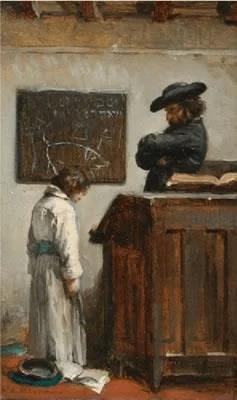
One of the most important things to a Jew throughout the ages has been education. Jewish education today and what it meant in the past for Sephardim are two completely different things. In centuries past, Sephardic Jews produced a wide range of literature, poetry, plays, philosophy and spiritual works. At the centre of all of this was the essential classical Hebrew texts of Miqra, Mishnah and the Talmud and the way's in which they were learnt. A thorough Jewish education did not create a closed and hermetic society, quite the contrary. Sephardim were able to combine their Jewish particularism to a universal humanism. This created a Jewish society that was observant but which also absorbed and learnt wider knowledge and had cultural overlapping with surrounding peoples. Very often, this way of life is mistaken for assimilation, when it was not the case at all. It was not simply a matter of one or the other (religious/secular), but an overlap that allowed Jews to follow their own laws and be members of the wider world. Rabbis once wrote works that were influential for Jews and non-Jews alike. Sephardic religious humanism provides an alternative to the secular/religious divide.
This page will attempt to give people the tools to study the Jewish texts and will provide some multimedia that will help re-orientate today's student to a more accurate understanding of Sephardi Judaism and the context in which it once thrived. Whereas in the past, Sephardi rabbis would produce vast volumes of work, today, we're lucky to get a prayer book out of most of our ministers. Sephardim producing poetry has completely dried up. Today, we process and understand data and information through alien binary's such as "Reform" and "Orthodox", "Secular" and "Jewish" and "Western" and "Eastern". These conflicting ideas are the result of European Judaism and German Idealism and do not have their roots in the Judaism which emerged from the Babylonian academies.
| 1.0 | Dictionaries |
| 1.1 | Miqra, Mishna, Talmud |
| 1.2 | Mishna |
| 1.2b | Targum |
| 1.3 | Talmud |
| 2.0 | Collapsing Timelines |
| 3.0 | Other Useful Reading |
| 4.0 | Reading Minhag into Jewish Law |
| 4.1 | Kol Isha (or not) |
| 4.2 | Electricity on Yom Tob (and Shabbat) |
| 5.0 | The "New Sephardim" and Sephardi Outreach Initiatives |
1. Dictionaries
One of the most important aspects of learning Jewish texts is the ability to read it in the original language. Here are some useful tools to assist in this.
| Author/Editor | Name | Publisher | ISBN | Description | Picture | Availability |
| Francis Brown, S. R. Driver, Charles A. Briggs | The Brown-Driver-Briggs Hebrew and English Lexicon | Tyndale House Publishers (1994) | 9781565632066 | Miqra | 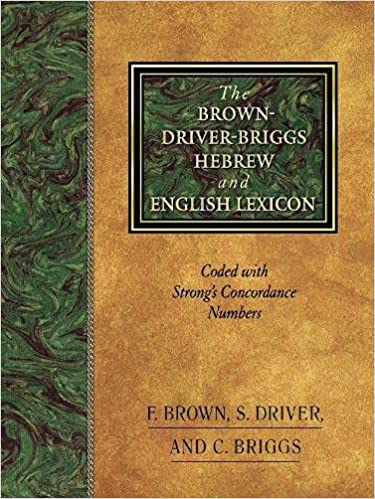 | -Yes Book |
| Marcus Jastrow | Dictionary of the Targumin, Talmud Bavli, Talmud Yerushalmi and Midrashic Literature | Judaica Press (2004) | 9781932443202 | Talmud and Midrash | 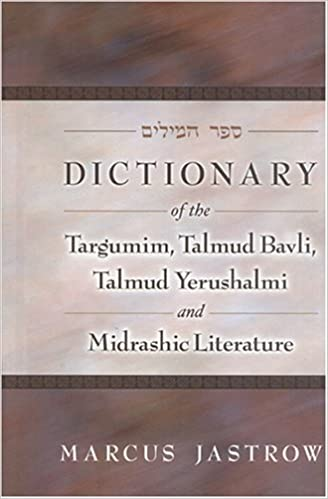 | -Yes Book |
| Michael Sokoloff | A Dictionary of Jewish Babylonian Aramaic of the Talmudic and Geonic Periods | Bar Ilan University Press (2003) | 9789652264053 | Aramaic of the Talmud and Geonic Period | 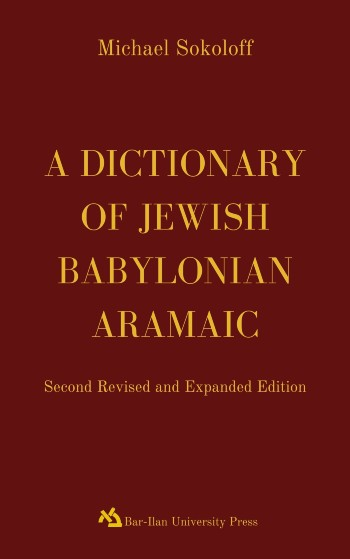 | -Yes Book |
| David Kimhi (annotated by William Chomsky) | Hebrew Grammar | Bloch Publishing (1952) | Hebrew Grammar | 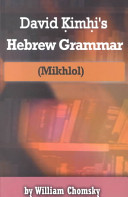 | -No Book | |
| Wilhelm Gesenius | Gesenius' Hebrew Grammar | 1909 Currently on Wikisource | Rabbinic Hebrew | 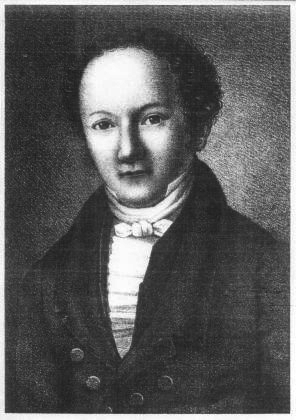 | -Online Click here | |
| There is an increase in digital dictionaries. They do not compare to the wealth of knowledge found in the physical books such as the Brown-Driver-Briggs dictionary, nor do they aid students in memorising their knowledge of grammar and Hebrew word roots IMO, Morphix contains a lot of words beyond Israeli Modern Hebrew and is useful for Jewish studies. | ||||||
Morphix Translation- Free Hebrew-English Dictionary  | Download here | |||||
| The following dictionaries are from the Spanish and Portuguese, Today, they are out of print, but are available online. | ||||||
| J. M. De Sola | A Vocabulary of the Pentateuch | 1865 | English-Hebrew | 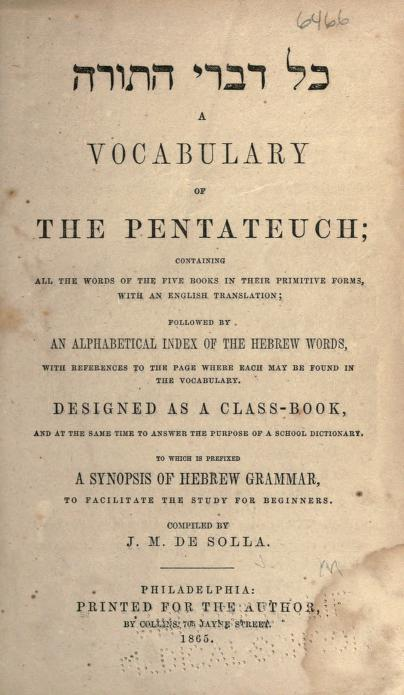 | -Online Click here | |
| David de Pomis | Tzemach David- Hebrew Lexicon | Italian-Hebrew | 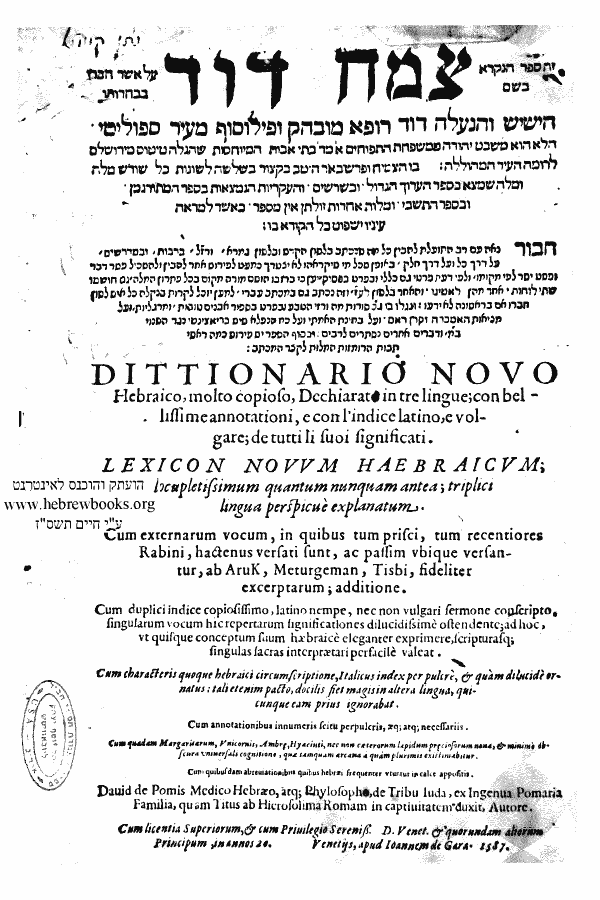 | -Online Click here | ||
| Selamoh de Olivera | Gramatica Hebrayca & Chaldayca | 5549 (1778) | Spanish-Hebrew | 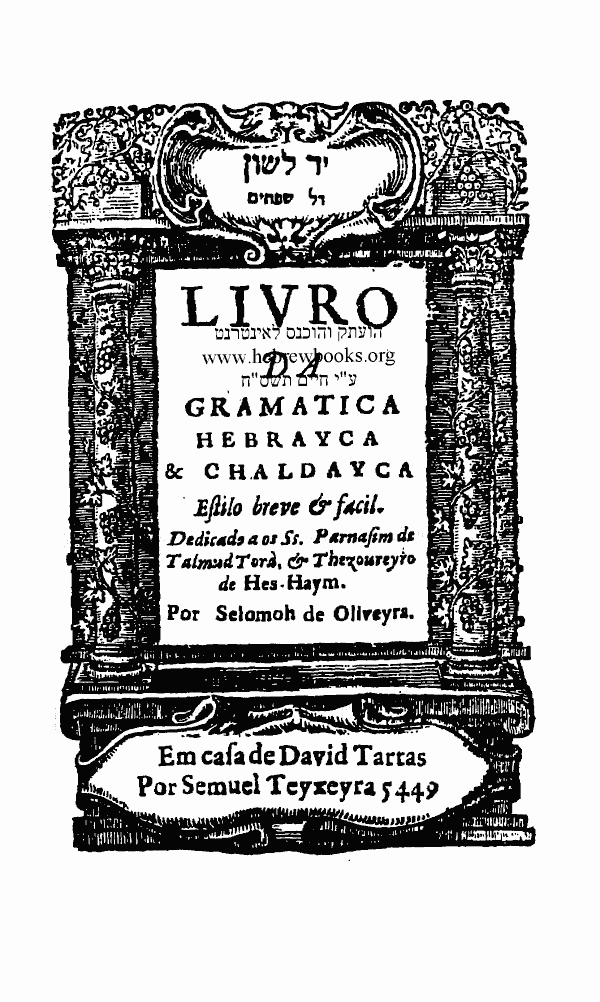 | -Online Click here | |
| David Cohen de Lara | De Convenientia Vocabulorum Rabinicorum | Spanish-Hebrew | 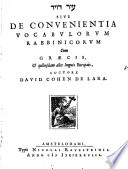 | -Online Click here | ||
| Mose Rafael de Aguilar | Epitome da Gramatica Hebraica | 5420 (1659) | Spanish-Hebrew | 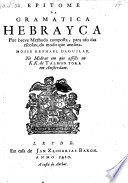 | -Online Click here | |
| Mose Rafael de Aguilar | Epitome da Gramatica Hebraica (II) | 5421 (1660) | Spanish-Hebrew | 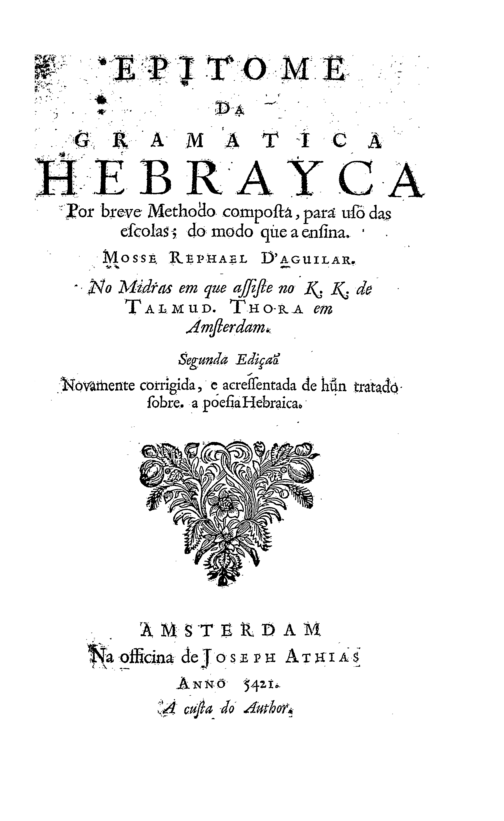 | -Online Click here | |
1.1 Miqra, Mishna, Talmud
These texts are three of Judaism's core books which a Jewish student will study. Owning your own Miqra can be tricky these days due to the editing process which reinforces certain ideas and ways of thinking. Of the three books I recommend here, one (the Soncino) gives the peshat of the text, the Hertz gives a mixture of Sephardic and Ashkenazic commentary but also looks into non-Jewish texts such as history and science to find supporting information. The third is a volume with Spanish commentaries from a mixture of old Sephardi and Ashkenazi rabbis.
| Edited by Abraham Cohen | The Soncino Chumash | The Soncino Press (1947) | 978-0900689246 | 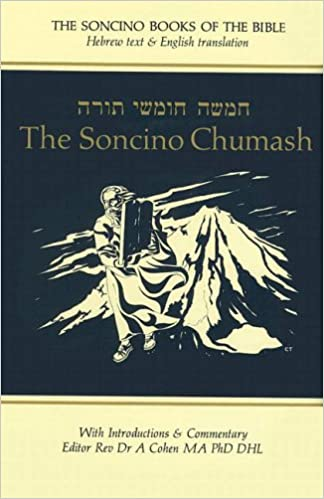 | |
| Rabbi Hertz |
| Sonico Press (1997) | 0980900689215 | 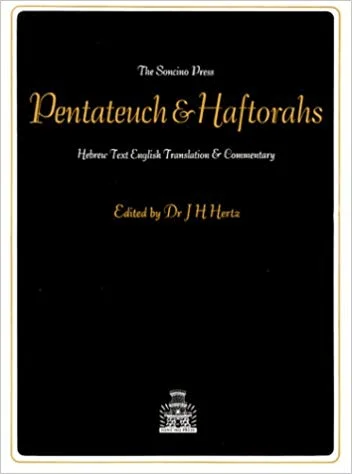 | |
| Rabino Marcos Edery | Miqra- Hebrew with Espanol | Link to online book |
1.2 Mishna
This book is supposed to be learnt by chanting it to a melody. Unfortunately this technique is being lost. Ammiel Alcalay commented in his book (After Jews and Arabs) that it was once possible to walk into a Yemenite Synagogue and hear the men and boys chanting the Mishnah or to go in on Shabbat and hear them reciting the Targum in Aramaic and that these traditions are being lost, with Judaism becoming homogenous and flat. I include below two editions of the Mishnah printed in Amsterdam with the Ta'amim that aid in it's recitation. There is also a short video from Rabbi DeMota giving an example of it's melody.
| רבי אבנדנה עם אדם בוראל |
| 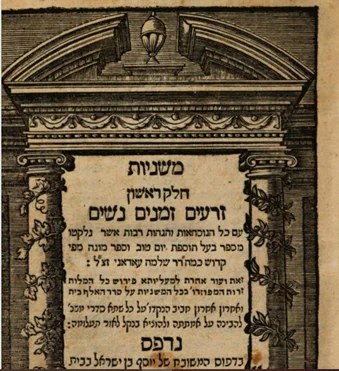 | ||||
| אמסרדאם. משנה | 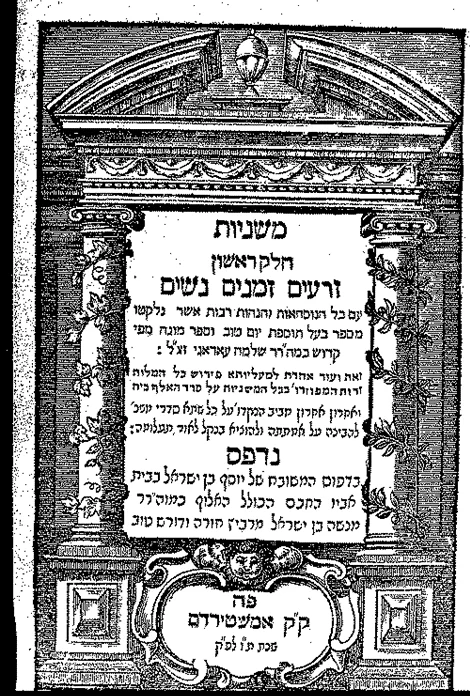 | Link to Text | ||||
| Rabbi DeMota | Mishna chant | Link to YouTube video |
1.2b Targum
To be studied on Shabbat the Targum should be a staple in any Jewish home. To quote David Ramirez from this article published below: "In Jewish tradition, the legal minutiae makes it obligatory to study the weekly portion of the Toráh twice in the Hebrew original, and once in its Aramaic translation of the Targum of Onkelos." Also included is an article from Rabbi/Professor Jose Faur regarding the Targum and Halakha.
| David Ramirez | Derashah, The Art of Interpetation in Jewish Law | David Ramirez Blog (22/02/18) | Link to article |
| Jose Faur | The Targumim and Halakha | The Jewish Quarterly Review (July 1975) | Link to essay |
| Author | Title | Publisher | Image | Availability |
| John Wesley Etheridge | The Targums of Onkelos & Jonathan Ben Uzziel | Hard Press (2018) | 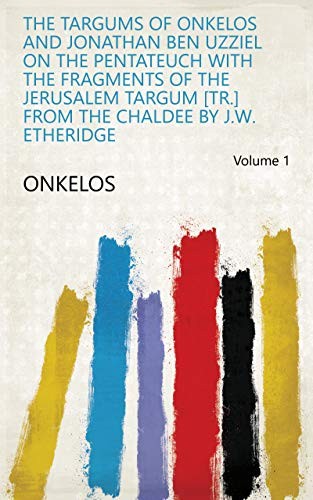 | Yes |
| Yitzhak Frank | Grammar for Gemara & Targum Onkelos | Toby Press Ltd (2016) | 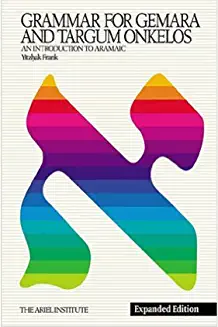 | Yes |
1.3 Talmud
Study of Talmud has become transformed by the Ashkenazi way of reading the text which is radically different from our own. It is this school of thought that has mostly won out today. Below are two books that will aid a student to study the Talmud the Sephardi way.
| יצחק קנפנטון | דרכי התלמוד | 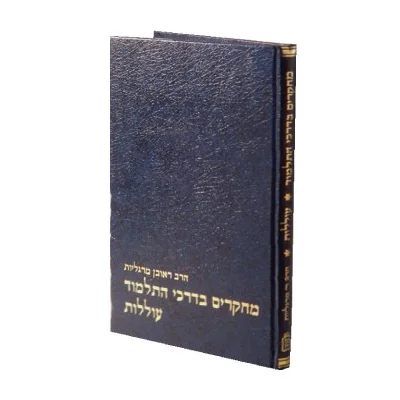 | The book is still in print Link to online edition |
| שלומה אוליורה | דרכי נועם | 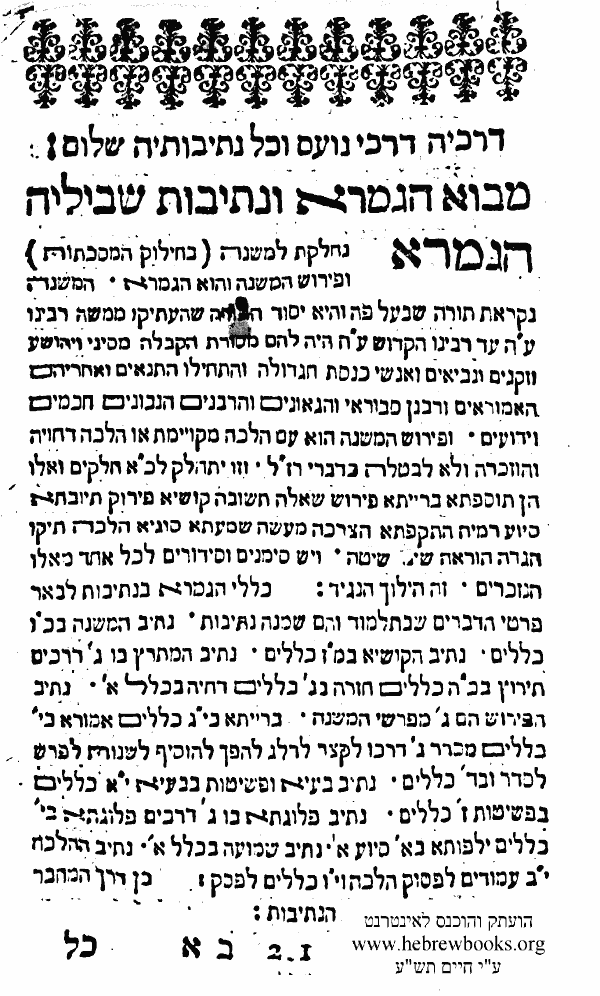 | Link to online text |
2. Collapsing Timelines
The history of Sephardic Jews is increasingly coming to be seen through the lens of European history and not through the lens of the wider histories of the world. Despite Europe being one of the most economically advanced regions of the world today, historically this was not the case and education, philosophical thinking and culture were to be found elsewhere. Jews in Europe experienced a shift in thinking with the "Age of Enlightenment" in the 17th and 18th century, followed by increased emancipation, allowing Jews to attend university and be part of civil society in a way which was not previously possible.
Sephardi Jews, most of whom lived around the Mediterranean basin and the Middle East already had centuries of learning in philosophy, science, grammar and linguistics, Greek and Arab thought and did not live isolated from the wider world. Quite unfairly, it's been assumed by many that all Jews lived in an intellectual darkness until the Enlightenment and those who did not live geographically close to this phenomenon remained in darkness until they were either "rescued" by the State of Israel in modern times, or emigrated to the Western World. The Alliance school network in the Islamic world is also seen as an example of how Jews in the East benefited from European education, though this school network was part of a colonial project often working against the native Jews and their relationships with non-Jews. Sephardim always had philosophical thinking, as evidenced by the rich rabbinic works produced by our rabbis and lay leadership and the vast volume of poetry and literature that complements this- something not seen in the Ashkenazi world.
Professor Yuval Evri was recently interviewed by Oxford University about this history in relation to contemporary Sephardi writers and the Middle East:
| Yuval Evri | Reconsidering Early Jewish Nationalist Ideologies | Oxford University: Israel Studies Seminar | Link to podcast |
Rabbi Joseph Dweck, the current leader of the UK Spanish and Portuguese Sephardi community gave several classes to a Jewish organisation called Torah in Motion in which he falsely claimed that Jews living in the Islamic world had no connection to modernity and that the rabbis had no philosophical thinking because they hadn't gone through the Enlightenment. Aside from the fact that they did have philosophical and very rich and complex thinking, related to studies in linguistics, science and the Hebrew texts, Enlightenment knowledge also arrived in places outside of Europe. For the Sephardim it was 'business as usual'. Rabbi Dweck based his talks on an essay written by Rabbi Joseph Soloveitchik called "Rupture and Reconstruction". Rather than challenge the false and racist narratives in this article, Dweck only reinforces them, something which he has done on several occasions. I wrote a critique of his lectures which you will find below:
| Yoel Pimentel | Nobel Savages: Rabbi Joseph Dweck's Unenlightened View of the Jews of the Arab World | Sephardic Heritage Update (13/01/2021) | Link to article |
Although I can't vouch for his other work and it's content, this class from Rabbi Joshua Maroof, correctly places Sephardim in their context as influential thinkers to both Jews and non-Jews alike:
| Rabbi Joshua Maroof | Sephardic Judaism: The Judaism of the Future | MYC Jewish Education |
3. Other Useful Reading
David Shasha from the Centre for Sephardic Heritage in Brooklyn New York, publishes an annual reading list to assist those on the path of Jewish study to select and learn from crucial texts. The list is a treasure trove of scholarship. Whilst many of the books appear on this website, here they appear in a well constructed and methodological way with brief but informative descriptions of many of the titles.
Sephardic Heritage Update - Building Your Library (click here)
His book of essays on Bereshit is also available online:
| David Shasha | Representing the Human Family: Essays on the Book of Genesis | 2002 | Link to book |
Miriam Gamliel from Yeshiva University has published a brilliant essay detailing the development of Jewish education and how Ashkenazim and Sephardim travelled along different roads in this respect. The following article was taken from the Sephardic Heritage Update.
| Miriam Leah Gamliel | Jewish Schooling through the Ages | History of Jewish Ed., Yeshiva University (2013) | Link to essay |
Rachmiel Ezra Travitz has written a number of essay's on Jewish law which can be found here
4.0 Reading Minhag into Jewish Law
4.1 Kol Isha (or not)
A worrying trend emerging in all of our communities is the practise of forbidding things permitted by the Talmud. One of things that is being forbidden in many of our communities is hearing women sing. The Talmud itself does not mention the word singing in the case that has come to be used as the deciding point on this matter. Below are some resources that should iron out this issue.
The Rabbi Joseph H. Lookstein Memorial Volume, a publication of Yeshiva University have presented the following essay which incorporates the many different understandings of the topic of hearing a women's voice. As the article demonstrates, the Sephardi rabbis did not prohibit this or even interpret the Talmud to be talking about singing.
| Saul J. Berman | Kol 'Isha | Yeshiva University | Link to essay |
Rabbi David de Sola Pool, the former leader of Congregation Shearith Israel encouraged women to sing in our congregations. See the sermon below:
| David de Sola Pool | Congregational singing | New York (1910?) | Link to sermon |
Rabbi Yehonatan Elazar DeMota has written an article on the subject:
| Rabbi DeMota | To Sing or not to Sing? | Facebook (17/01/2010) | Link to Google Doc |
One of the most knowledgeable members of the Iraqi Jewish community was Flora Sassoon who was known to have read from the Torah in the Synagogue:
| Jennifer Breger | Flora Sassoon 1859-1936 | Jewish Women's Archive | Link to article |
Mixed choirs were once a feature in a number of Synagogue's and this is still the case in a small number. Below are some resources showing how Jewish communities were once at ease with women singing, before great pressure came to bear on many of them.
| Kinor and Hazamir singing an arrangement by Eyal Bitton | Ah! El Novio- Ladino Wedding Song | Montreal Spanish and Portuguese Synagogue (March 2000) | Click here to see YouTube video |
| Vanessa Paloma | En Kelohenu | Bennaroch Synagogue, Cassablanca (annual event) | Click here to see YouTube video |
| Saul Marks | Our Choir (mixed) | Princess Road United Syangogue (Ashkenazi Orthodox) | Click here to read the article |
| Abraham Levy | A Rocky Road: Memoirs | Halban Publishers (2017) | Quote from p.60: "It (Hampstead Synagogue) was then the last United Synagogue to maintain a mixed choir and the lay leaders wondered how I felt about it." |
Unfortunately, a recent publication from the Montefiore Endowment called 'Memorable Sephardi Voices' has become memorable for all the wrong reasons. The editors and contributors of the book have not relied on the classical Sephardic stance on the aforementioned discussion, but have instead, taken the legal rulings of two later Israeli rabbis Haim David HaLevy and Ovadia Yosef, who forbid hearing women sing, most likely as a result of the more Haredi environment they were emerged in, in Israel.
| Compiled by Lucien Gubbay | Memorable Sephardi Voices | Montefiore Endowment (2020) | Link to the book |
The book also makes this rather false claim: "Originally intended to prevent immorality, the Gemara and the Shulhan Aruch strictly forbid men to listen to the voices of women singing. That did not worry the non-European Sephardi sages who mostly lived in the old Islamic world. Consequently, in this particular area, it is perhaps understandable that their discussions do not differ markedly from those of their usually more stringent Ashkenazi counterparts, some of whom may have been more exposed to Enlightenment ideas. Rabbi Yehudah Henkin, for example, stated that because the mitzvah of ‘hearing’ the Shofar and the Megillah cannot be performed through the radio, Kol Isha does not apply to women’s voices on the radio (See 3.5.1 below)." Thank you to WJDO for pointing this out to me.
The aforementioned book does not cite rabbis from the Islamic world, who, as you'll see from the Lookstein article did not even understand the Talmud to be talking about singing. Instead they use Israeli rabbis who are no doubt going to start forbidding things. I'm not sure why Rabbi Henkin's confused mess is included.
4.2 Electricity on Yom Tob (and Shabbat)
The book also forbids the use of electricity on Yom Tob. Again, more contemporary Israeli rabbis are used to bring the judgement on this and not the classic Sephardic rabbi, many of whom are listed in the back of the book. The use of electricity on Shabbat and Yom Tob was not forbidden by the old rabbis, but the whole idea of this book is to promote Modern Orthodoxy and when Sephardic Judaism comes up against that, Modern Orthodoxy wins. The first video below is of an a man from Syria discussing this in the context of his home country. Thank you to Luna Skye for compiling a number of resources on her website about electricity on Yom Tob including a list of rabbis and how they ruled on the subject.
| Electricity on Yom Tob | Link to video | ||
| Luna Skye | Electricity on Shabbath and Yom Tob- sources | Luna's Jewish Repository | Link to webpage |
4.3 Dancing and Clapping on Shabbat
There is also the issue of permitting what is forbidden. Rabbi DeMota covers the issus of dancing and clapping on Shabbat below:
| Yehonatan Elazar-DeMota | Dancing and Clapping on Shabbat | Facebook (08/11/17) | Link to article |
5. The "New Sephardim" and Sephardi Outreach Initiatives
We've seen a growing crop of putatively Sephardic outreach organisations. The problem with many of these initiatives is that they are often started by people who have not received the correct training and education themselves. The content tends to fall into one of two categories: food, music and folk traditions or religious ritual only. Neither of these cover the broad and complex output of Sephardim over the centuries including our involvement in poetry, literature, science, philosophy, philanthropy and of course the wider body of thought that lies within the rabbinic system itself and the methods and curriculum deployed to create this wealth of knowledge.
I've also noticed an increase in reference to the late rabbi Jose Faur, whose life's work provides one of the last threads connecting the Sephardi past to the present. During his life, I only heard him mentioned by two people. A sudden interest in his works started to ferment in the year leading up to his death and has since snowballed. Many of the people mentioning him, are still promoting rabbis whose legal methods and way of thinking are representative of the school of the Tosafot that Rabbi Faur critiqued in his seminal essay below:
| Rabbi Jose Faur | The Legal Thinking of the Tosafot: A Historical Approach | Originally published in Dine Yisrael, volume VI (1975) |
In London there is the "Habura". Their project seems less aimed at restoring the classical Sephardic heritage and more about creating an outreach organisation that can make an impact on the wider Modern Orthodox world. "Old Sepharad" is the marketing slogan, but rather than getting Maimonides, often we get Nachmanides. Sephardi and Sephardi hater are presented in the same context and it's clear that Sephardi Judaism is being presented in a way which de-contextualises our sages and places them in a framework solely about Jewish ritual. The content has fallen victim to the marketing and there doesn't seem to be a structured curriculum that would create a literature Jew. It could be a good program if the material was organised and presented within it's correct context and different schools of thought were understood and explained, but that is not the intention. The intention seems to be to create a "big tent" Jewish unity, but instead of including Ashkenazi thinkers who are on the same wavelength as our old sages, we get the likes of Soloveitchik, Kook and Hirsch. Whilst there are some good classes amongst their mass of content, one has to be careful to separate all of this out. Many of the students who follow this program are not literate in Judaism or knowledge in a way in which they are able to do this. The following will showcase some of the decent material.
a. Sephardic Education
The following class explains a little about Sephardi education in Syria. Thank you to Natan Abrahami for listening to the class and picking out the following important points: 1. Original Talmud Torah had both Jewish studies and wider general studies and there was no distinction between those works like today (secular/religious). 2. Teachers were Jewish, non-Jewish, men and women. 3. Schools were for both boys and girls, many times studying together. 4. Boys would study during the day, pray in the Synagogue (no separate minyan for the Yeshiba) and sleep at home. It was a tight knit community, but no sequestering of boys for the time that they were in Yeshiba. 5. The Alliance School focused on general studies and the teachers were often openly violating the Sabbath.
| יוסי דאיה | החינוך הספרדי: סדר החינוך בחלב במאה ה-20 | 17/01/22 | Link to YouTube video |
The following essays demonstrate that learning was broad in the Sephardi Talmud Torah (thank you to William Jeudah de Oliveria for sharing these) and that it has now been lost:
| נסים ליאון | ישיבת פורת יוסף: מחידוש היסטורי למיטוס אתני | פעמים: רבעון לחקר קהילות ישראל במזרח | 2013 | Link to essay |
| שלומה גליקסברג | בתי מדרש לרבנים בנשיאות הראשונים לציון: רצף כמעט ללא תמורה | פעמים: רבעון לחקר קהילות ישראל במזרח | 2013 | Link to essay |
| יעקוב לופו | הצלת יהדות מאראקא לתורה: הוצאת תלמידים ממורוקו לישבית ליטאיות אחר השואה | פעמים: רבעון לחקר קהילות ישראל במזרח | 1999 | Link to essay |
Rabbi Abraham Levy mentions in his biography how it was the Ashkenazim that rejected general studies with Jewish learning. This again contradicts the Solovetichik/Dweck thesis that Sephardim were not modern:
| Abraham Levy | A Rocky Road: Memoirs | Halban Publishers (2017) | Quote p.34: "When Sir Moses offered to give money to yeshivot to teach their students Arabic, there was an outcry from the religious leadership, which objected to introducing any subject into their institutions other than Talmud." |
This brings us to another outreach initiative which frames Sephardim in a Modern Orthodox context, with no mention of the world in which they lived and learnt. The content is related to religious ritual only and Rav Kook and his Religious-Zionist philosophy is a firm favourite. Amongst all that however, is this class on Haham Shem Tob Gaguine. Again, we learn from this class that the Sephardi centre for rabbinic learning taught general studies also (languages, mathematics, science) and that it was the Ashkenazim who opposed this, contrary again to ideas circulating that Sephardim lived in some kind of hermetic Torah Shtetl for centuries.
| Yonatan Halevy | Exploring Jewish Giants: Shemtob Gaguine | Shiviti (01/12/20) | Link to YouTube video |
Returning to the Habura and education, they have presented this class from Rabbi Aron HaLeva which is about the Geonic-Andaluscian Talmud. Also included is a podcast covering the same ground by Rachmiel Travitz and a class on rabbinic authority from Rabbi Alan Yuter:
| Rabbi Aron Haleva | Talmud in the Geonic Andaluscian-Tradition | Habura (20/06/21) | Link to YouTube Video |
| Rachmiel Travitz | A talk on rabbinics | Building Jerusalem (31/05/22) | Link to Podcast |
| Alan Yuter | The Modern Orthodox Rabbi's Authority as Poseq | Torat Chayim (25/06/18) | Link to YouTube Video |
| Professor Zvi Zohar | The Approach of Hakham Benzion Uziel | Habura (01/10/20) | Link to YouTube Video |
| Porfessor Zvi Zohar | The Approach of Yisrael Moshe Hazzan | Habura (09/12/20) | Link to YouTube Video |
| Professor Matt Goldish | A Window Onto the Everyday Life of Sephardim: Through the Lens of Teshubot | Habura (20/01/22) | Link to YouTube Video |
